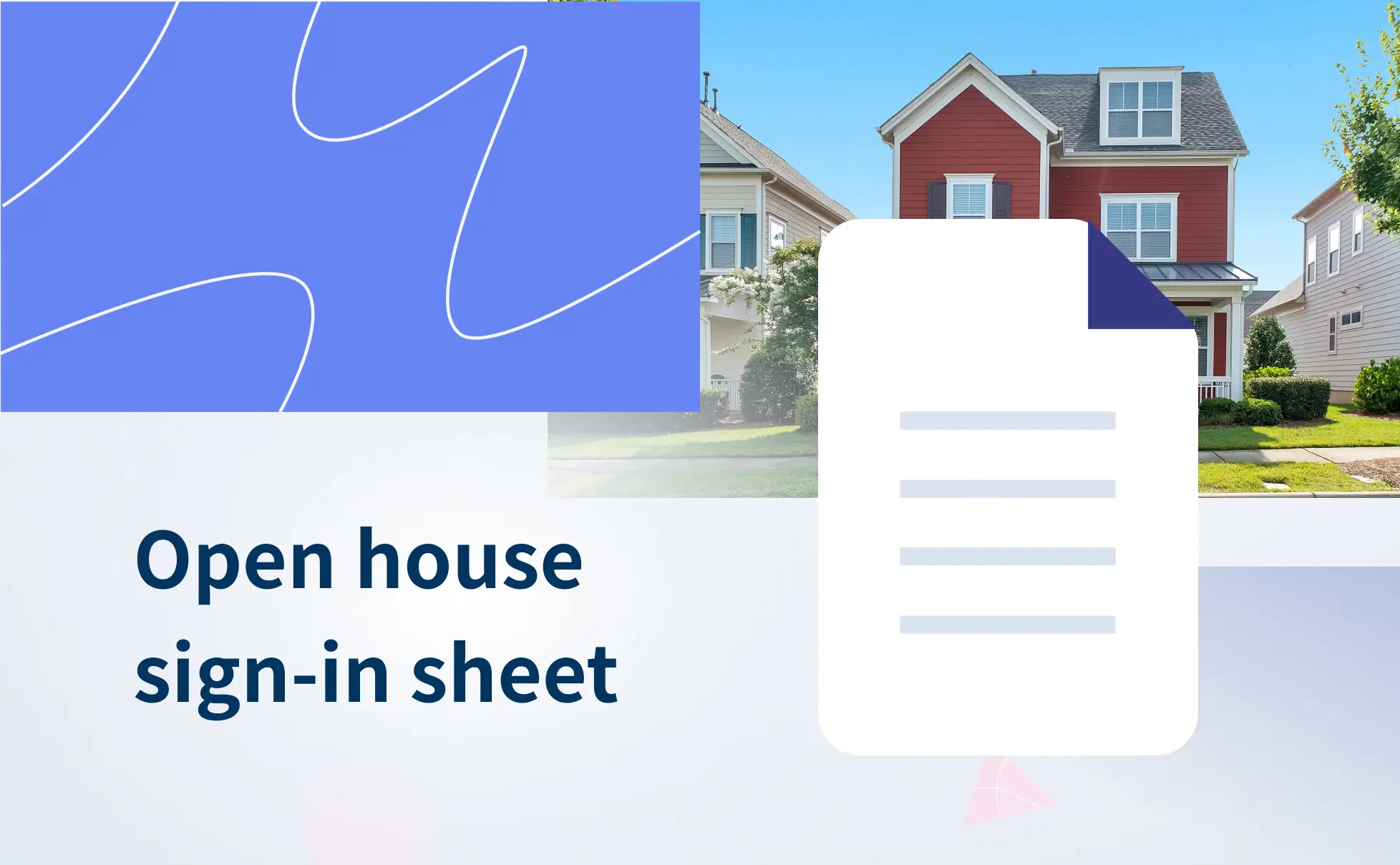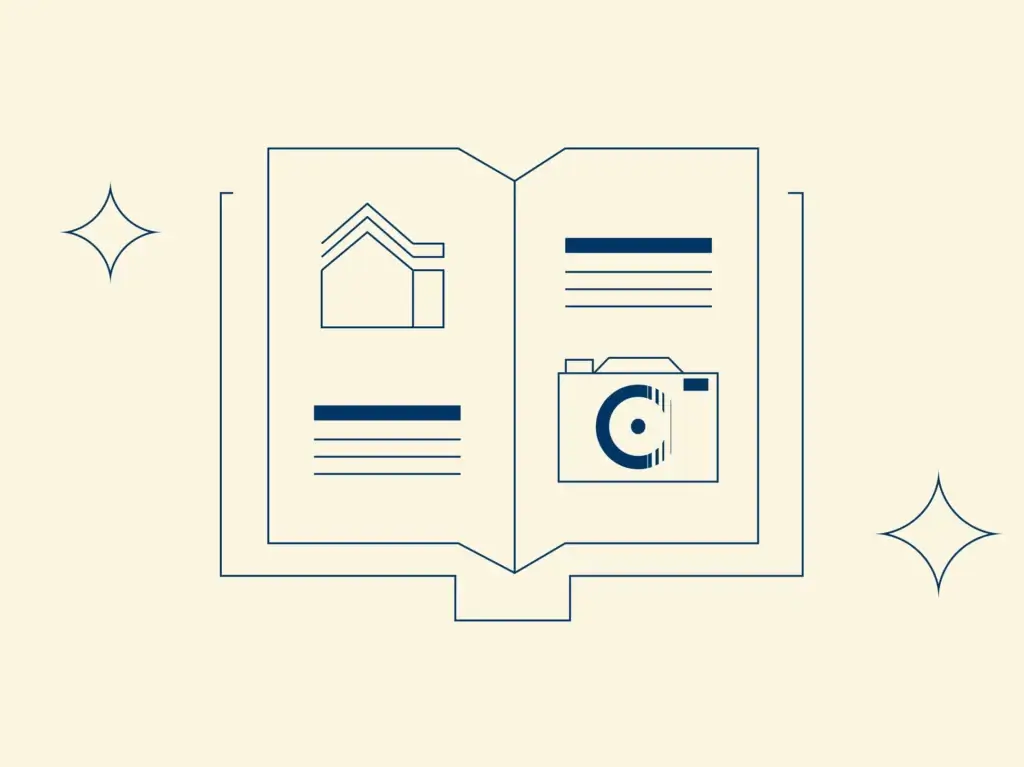For homebuyers, a successful open house can be a first opportunity to walk through a space they might eventually someday call their own. For real estate agents, an open house can be a perfect place to find active buyers who are qualified and motivated to purchase a house soon — a chance to meet new people, grow your client base and generate leads.
But turning an open house into a revenue-generating activity is easier said than done. To capture information about open house visitors and follow up with them late with accurate information, real estate agents typically use some kind of an open house sign in sheet — either digital or on paper.
We’ll walk you through the basics of creating your own open house sign-in sheet template, one that works best for your needs. But first, a little bit about the open house event itself.
How do you promote an open house?
The nice thing about open houses is that in a seller’s market, you’ll have buyers interested in the event almost no matter what you do. They need to buy a house; you have a house for sale; they have time to tour it; the house is available to tour. It’s a no-brainer!
Things get a bit trickier when you’re trying to advertise an open house in a buyer’s market, where the number of homes for sale outweigh the numbers of available buyers. This typically means buyers can pick and choose how they want to spend their time (and on which homes), which means you might have to try harder to get buyers in the door to your open house.
Social media is one of the best ways to promote an open house in 2024. Creating a Facebook event and open house hashtags to share across platforms can get people excited about your open house. Include all the information on the house including the physical address, details on the property as well as answer some basic questions upfront: what is the neighborhood like? What are the strong points of the house? What amenities does the neighborhood have?
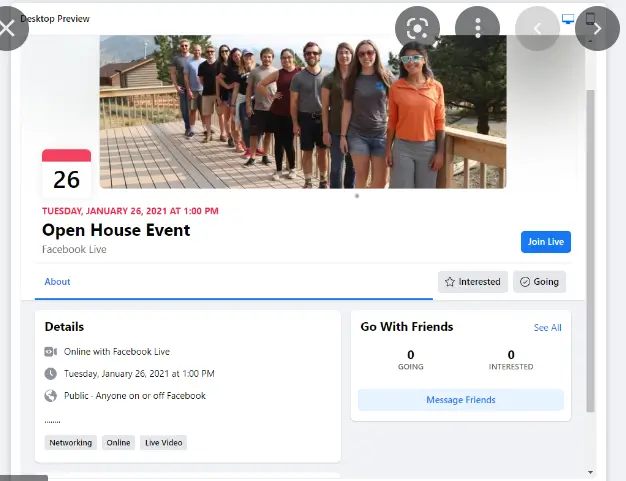
Photos are important, too! Yes, the open house guests are going to be seeing the property in person— which is why you should tease their interest with some detail shots of the place, as well as an exterior or two. If the backyard is a built-in gathering place, then maybe setting it up as if for a party and taking some photos will get people excited about seeing it in person, and dreaming up their own (housewarming) party in the same space.
Don’t neglect the power of agent-to-agent marketing, either! Tell the agents in your bubble that you have an open house taking place and when it is. Send emails to your existing list, post fliers in the local coffee shops, and you can even consider placing a classified ad in your local print paper (they still exist in some places!).
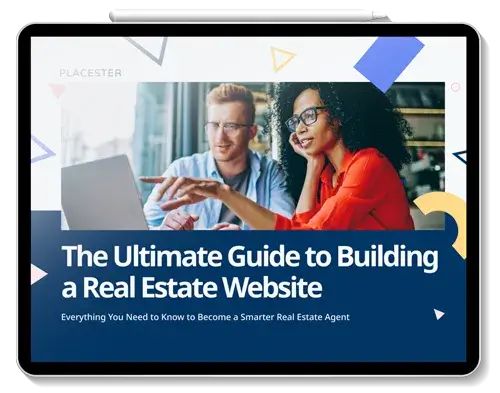
What should be on an open house sign-in sheet?
You’ve set a date for your open house, and you’ve spread the word that it’s happening. Now you need to make sure your sign-in sheet is ready for action.
What should go on an open house sign-in sheet? It really depends on your goals for the open house. First of all, try to answer the basic questions:
- Are you actively trying to generate more buyer leads?
- Are you trying to create a data-based report for your sellers around the types of buyers interested in their home?
- Is there another goal you’d like to accomplish?
At the very least, you will want to ask open house attendees to provide their basic contact information such as names, phone numbers or an e-mail address. A form can be as simple as two fields, and you can even avoid asking clients for their “preferred” contact method — they’re only providing you with one, after all.
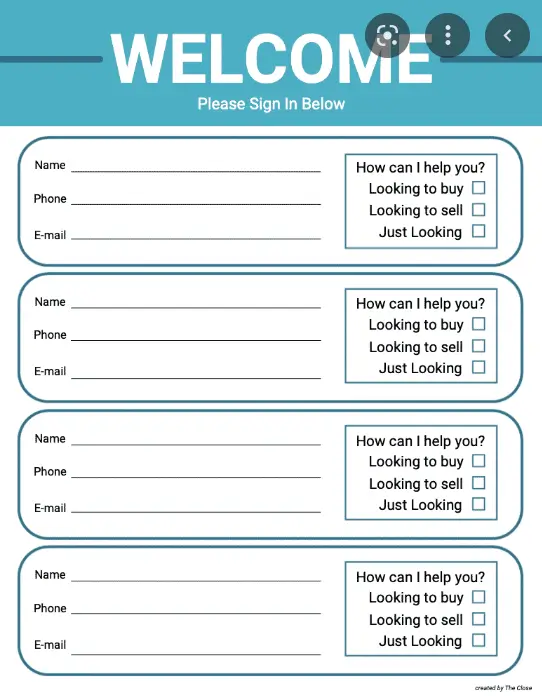
A good sheet shouldn’t be too time consuming. The longer your open house form is, the more difficulty you are likely to have in getting your attendees to fill the whole thing out. So consider carefully how much additional information you really need for it to be completed quickly with the intention of streamlining your form at the same time.
What else would you want to ask? Some larger forms include many or all of the following additional questions that will help you gather more information:
- Are you working with a real estate agent?
- Are you buying, selling, or both?
- Are you pre-approved for a mortgage? What is your homebuying budget?
- Are you a first-time homebuyer?
- What kind of real estate are you interested in seeing?
- Single-family homes
- Bed/bath count
- Features
- Condos
- Bed/bath count
- Features
- Lots/land
- When are you looking to buy?
These questions can give you a sense of whether the visitor needs a real estate agent to represent them, has a house to list, what kind of asking price you might be working with if they decide to make an offer on the house, and whether you might have any other listings that interest them if this one doesn’t. Some open house software and apps give you quiz flow-type options that don’t require everyone to answer the same (possibly irrelevant) questions.
You might also consider offering some sort of incentive for filling out the form if it starts approaching the long side of the spectrum, such as entry into a drawing to win a gift card to a quality local restaurant.
One of the simplest tools you can use to create an open house sign in sheet template is through a spreadsheet in a platform like Microsoft Excel or Google Sheets. (Because Google has the free option, we’ll walk you through some template basics for Sheets.)
There are a few existing free templates in Google Sheets resources that might be able to accommodate an open house sign-in sheet, but you’re probably better off starting a new Google Sheet project entirely and tailoring it the way you want it.
This is a project that many designers can help you with, saving it as a template for you to use for every next open house event. When the Sheet looks the way you want it to, you can submit it to your Google organization’s template gallery by visiting the template gallery (you can find it through the Google Sheets page when you’re signed in to your account). Then click on your organization’s tab and click “submit template.” If your brokerage already has a template you can use, that’s even better!
How to use the open house sign-in sheet for lead generation online?
An app or software program, on the other hand, can export your new contacts to your CRM via a spreadsheet or sometimes even directly, which can be very handy!
You’ll definitely want to check and see whether your visitors are actively looking to buy or just looking around — and don’t dismiss the “lookie-loos,” as many real estate agents might. Some of them could very well be current homeowners who could be looking to list their own house for sale in a year or two, and being in touch with people like that is not a bad idea for a real estate agent!
Try to assess whether your open house guests are active buyers or current homeowners (or both!) so you can address their needs accordingly. Buyers who are already working with a real estate agent can benefit from your knowledge of the market from a seller’s perspective, and it never hurts to ask them if they want to sign up for a newsletter about your latest listings, appropriate “coming soon” teasers or even your next open house event. Current homeowners might be interested in seeing “recently sold” reports, home design and maintenance ideas, and the like.
3 Steps to Get Attendees to Complete Your Open House Sign-in Sheet templates
This doesn’t have to be rocket science! There are a number of ways to ask your attendees in a friendly, appropriate way to sign in and encourage them to leave accurate contact information for a follow up.
Step 1: Ask them directly when they walk in the door
Depending on how busy your open houses tend to be, you can ask everyone when they walk in to complete a digital open house sign in and hand them your iPad, or have them scan your QR code — whatever the case!
If your open house events are super busy, consider enlisting some help so that attendees feel like they’re getting personal attention from someone as a “host.”
Step 2: Give them a good reason to let you contact them
While you ask, you can explain why you’re asking them to sign in, and why it’s to their benefit. Of course, the seller wants to know (and many would argue has a right to know!) who is walking through their house. But that doesn’t sell an attendee on why they should let you talk to them again.
In a friendly way, ask your attendees if they’re considering buying a house or just looking before you ask them to sign in. Then you can ask them to sign in and provide some kind of “carrot” that’s tailored to them.
For example, if your attendee says they’re looking to buy a house, then you can reply, “That’s great! If you have any questions, definitely let me know. And if this house isn’t a great fit for you and you’d like to hear about others that could be more along the lines of what you need, then I can send you those directly and loop in your real estate agent, too, if you have one.”
If your attendee says they’re really just looking around because they’ve always wanted to see the inside, then you might say, “If you’re curious about real estate in this neighborhood, I have a hyper local market report that goes over what homes sold and for how much, and also has more open house announcements! You can sign in here to learn more about it.”
Save them some time by recording some of their responses and then handing them a partially completed form to finish. And let them know that the more specific they can be with their answers, the better you can tailor any future communications you send them, but don’t turn up the pressure for potenatial buyers to tell you exactly what their pre-approval budget is (for example).
Try saying: “This information will help me find the best houses to send to you, so the more I know about you the better match I can make,” with just a small handful of required fields (such as name and contact information) and copious optional fields.
Step 3: Give them some kind of freebie
This might not work for every open house or in every market, but consider offering some kind of gift card or incentive drawing for everyone who signs in to the open house.
You might offer to buy everyone a cup of coffee or a round from the hippest bar in town (their choice). Or you might create a raffle for a larger prize, such as $50 or $100 to a solid local restaurant.
If you tell them you’re not going to spam them, offer a good incentive to sign up, and are friendly and ask face-to-face, then most people are going to be amenable to giving you the information you’re seeking.
I Got Some Open House Leads! Now What Do I Do?
First, you’ll need to ensure you can follow up on any promises you made when you were asking your open house attendees to fill out the open house form. Depending on how many leads you got, you might want to check that they’ve been correctly documented in your CRM as interested buyers, sellers, or homeowners, and then decide what kind of information you might want to give them.
This is where marketing automation can come in really handy. If you’ve got established mailing lists for homeowners in certain ZIP codes or who own certain types of houses, then you can add your new contacts to those mailing lists. If you have yet to set up those kinds of touch points for people who could use your services in the future, talk to us — we have resources that can help you create the best campaigns for your needs.


